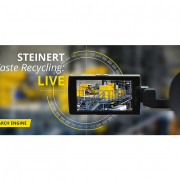Recycling Mixed Plastics: Method without Climate Impact
According to Swedish Chalmers University of Technology, its recycling method could decouple new plastic products from the supply of new fossil raw materials.
As reported, researchers at Chalmers have demonstrated in a study how the carbon atoms in mixed waste can replace all fossil raw materials in the production of new plastic. “The recycling method is inspired by the natural carbon cycle and could eliminate the climate impact of plastic materials, or even clean the air of carbon dioxide,” the university gave account.
“There are enough carbon atoms in waste to meet the needs of all global plastic production. Using these atoms, we can decouple new plastic products from the supply of virgin fossil raw materials. If the process is powered by renewable energy, we also get plastic products with more than 95 percent lower climate impact than those produced today, which effectively means negative emissions for the entire system,” Henrik Thunman, Professor of Energy Technology at Chalmers University of Technology, is cited. He and his research team want to focus on the carbon atoms in waste, which is currently incinerated or ends up in landfills instead of being recycled. According to the information, this is made possible with technologies targeting the carbon contained in plastic, paper and wood waste to create raw material for the production of plastics with the same variety and quality as those currently produced from fossil raw materials.
Advanced methods
Current plastic recycling methods are able to replace no more than 15 to 20 percent of the fossil raw material needed to meet society’s demand for plastic. “The advanced methods proposed by the researchers are based on thermochemical technologies and involve the waste being heated to 600-800 degrees Celsius. The waste then turns into a gas, which after the addition of hydrogen can replace the building blocks of plastics. Using this recycling method could decouple new plastic products from the supply of new fossil raw materials,” the university described the process. The researchers were developing a thermochemical recycling method that produces a gas, which could then be used as a raw material in the same factories in which plastic products are currently being made from fossil oil or gas.
Different types of waste, such as old plastic products and paper cups – with or without food residues – were put into the reactors at the Chalmers Power Central. “The key to more extensive recycling is to look at residual waste in a whole new way: as a raw material full of useful carbon atoms. The waste then acquires value, and you can create economic structures to collect and use the material as a raw material worldwide,” Henrik Thunman was quoted. According to the researchers’ calculations, the energy to power such processes can be taken from renewable sources.
The research has been carried out as part of the FUTNERC project, funded half by the Swedish Energy Agency and 25 percent each by the companies Borealis and Preem Petroleum AB. It aims to accelerate the transformation of the chemical industry to achieve net-zero greenhouse gas emissions from refineries and chemical plants by 2050. The study “Co-recycling of natural and synthetic carbon materials for a sustainable circular economy” (www.sciencedirect.com/science/article/pii/S0959652622022739?via%3Dihub) was published in the Journal of Cleaner Production. Authors are Isabel Cañete Vela, Teresa Berdugo Vilches, Göran Berndes, Filip Johnsson and Henrik Thunman. The researchers are active at Chalmers University of Technology.
(Published in GLOBAL RECYCLING Magazine 3/2022, Page 44, Source: Study “Co-recycling of natural and synthetic”)









